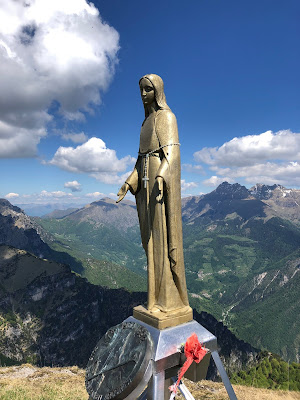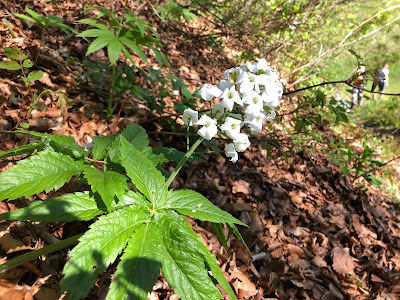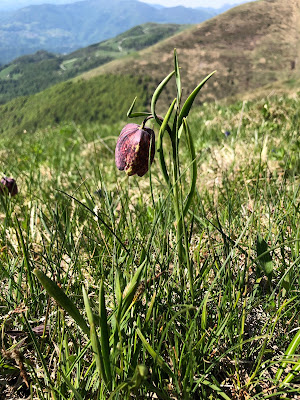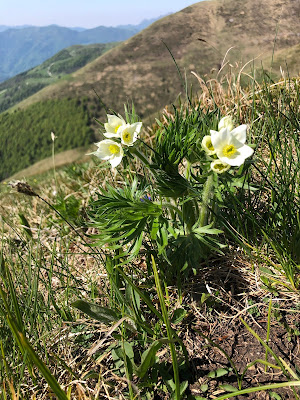Upper left: Views of snow-capped mountains surrounding Rifugio Gherardi in the Val Taleggio. Upper right: Hiking tracks for a journey to Rifugio Gherardi. Bottom left: Approaching Passo Baciamorti. Bottom center: View from Pizzo Bacciamorti toward Monte Aralalta. Bottom right: Road leading to and from Rifugio Gherardi with Monte Cancervo in the distance, left.
Overview
Length: 13.4 km (8.3 mi)
Duration: 6 hours total, including 1.5 hours for lunch at Rifugio Gherardi.
Elevation: Minimum altitude 1,290 m (4,232 ft) at Capo Foppa, max altitude 2006 m (6,581 ft) at Pizzo Baciamorti; total gain of 1,024 m (3359 ft).
Location: Italy, Lombardy, Val Taleggio
Getting There
We got a lift with friends, but there are buses that can get you as far as Pizzino. By car, drive up Val Brembana, take a left at San Giovanni Bianco, and follow Strada Provinciale 25 more or less west toward Taleggio. From Taleggio center, head up toward Pizzino until you reach a pull out in the road (here) and there is a sign for Capo Foppa. Stop and put 2 euros in a machine to be able to use the road. Then, continue on via Arighiglio to the end of the road where at Capo Foppa, where you can park.
There are a couple of interesting things to point out along the journey to Taleggio. First, in the cute little center of San Giovanni Bianco, you will be greeted by the statue of Vistallo Zignoni. Who is he you ask?
Vistallo Zignoni was an Italian mercenary who lived between the 15th and 16th centuries and is reputed to have brought a piece of the crown of thorns (sacra spina) to San Giovanni Bianco in the Val Brembana. The “holy relic” was booty from a battle Zignoni fought in 1495. Zignoni, who was banned from his homeland of Val Brembana (under the rule of Venice at that time), got the mercenary idea to use the holy thorn as a bargaining chip. (What would Jesus do?) From the doge and senate of Venice, Zignoni was able make a deal and turn over the relic and in return receive a life pension for himself and family members as well as get his ban from his homeland lifted for 100 years. Even more, in the deal, he was able to keep part of the relic and bring it back home where it lives today in the Reliquia Sacra Spina facing the statue in San Giovanni Bianco. And everyone lived happily ever after.
The second interesting thing about getting to this hike is that after leaving San Giovanni Bianco, you take Strada Provinciale 25 to Taleggio. This takes you through the Orrido della Val Taleggio. Orrido as an adjective means “horrid” but also a noun means “ravine” or “gorge”. SP 25 winds its way through a very narrow and gnarled canyon, first on one side of the river Enna, then on the other side, then back again. It’s a fascinating 15 minutes passing through the orrido.
The third interesting thing about this hike is that you are in VAL TALEGGIO, all-caps intentional shouting. Just hearing the word Taleggio evokes the taste sensation of that soft and aromatic cheese that has been around since Roman times. Outside of Italy, Taleggio cheese is - for lack of a better word - more industrial, with an orange-colored rind and a moderate flavor. The Taleggio cheese you buy locally, is less orange looking and more aromatic. So, when passing through Pizzino be sure to pick up some Taleggio cheese. We stopped at Alimentari Pesenti and got a hunk of it as a reward for our hiking efforts.
Left: The statue of Vistallo Zignoni in San Giovanni Bianco in Val Brembana. Center left: The statue of Vistallo Zignoni faces the church that contains the hold relic he won in battle. Center right: A hunk of Taleggio cheese purchased in Val Taleggio. Right: La Madonnina of Pizzo Baciamorti.
The Hike
The goal of the hike is to reach Rifugio Gherardi, but there are a couple of ways to do it. The most obvious and easiest way is to take Sentiero 120, which takes you straight up to Rifugio Gherardi on a paved and then dirt road that’s easy walking. We took this on our way back.
To get to the rifugio, we opted for a longer, scenic route going counterclockwise. We followed Sentiero 153 (Capofoppa to Passo Baciamorti) toward the pass and then we picked up the trail to Pizzo Baciamorti (2006 m). Going down from down from Pizzo Baciamorti, you join up with Sentiero 101_1 for short bit and then switch to Sentiero 120, which takes you to Rifugio Gherardi. Alternatively, from Passo Baciamorti you can also skip Pizzo Baciamorti and follow Sentiero 101_1.
The name of the pass (passo) and peek (pizzo) Baciamorti loosely translates to the suggestive "kiss the dead". We wondered why and went looking for an answer. An Eco di Bergamo article (in Italian) talked about the possible origins of the name. One of the explanations we found the most plausible is that the name derives from a corruption of the original name over the centuries. According to the local historian interviewed in the article, in the 13th century, this location appears on deeds as "masione mora" (dark house) likely referring to the hut that still is found just below the pass (and shown in photo with this post). In maps from the 16th century, the location is referred to as "Masamoro", then two centuries later as "Vasamoro". In a map of the 1800s, the name "Basamorti" is used. It's not a leap to go from that to "Baciamorti". Some of the other explanations of the name come from the fact that the pass was the boundary between warring clans and they used to exchange the dead from the skirmishes at this point. And everyone lived happily ever after.
Rifugio Gherardi is at 1650 m (5,313 ft) and is named for Angelo Gherardi, an expert ski-climber who died accidentally during a winter ascent to the Corno Stella on December 29, 1974. Rifugio Gherardi opened in 1987.
Back in August 2017, we tried to go up Corno Stella and backed out when the trail got a bit too much for us. That was summer. We can’t imagine what it would be like in winter. For more information on that hike, see our post A Hike to Lago Moro above Foppolo.
Being relatively easy to reach, on the weekends expect to find lots of families with blankets spread out and kids playing on the ample green space around Rifugio Gherardi. It’s part of the experience. Grab a picnic table outside, order your food, and kick back.
Left and center left: Homemade cake and pasta dish at Rifugio Gherardi. Center right: The menu at Rifugio Gherardi including, on this day, pasta, brasato, arrosto and zuppa farro e orzo. Right: View of Rifugio Gherardi.
Left: Hike tracks and position in Val Taleggio. Center left: Hike summary statistics from ViewRanger. Center right: Sign at Passo Baciamorti. Right: Hiking in Val Taleggio - view from Sentiero 153 looking south.
Flora
For more on flowers found around Bergamo, especially in the Bergamasque Alps, see our Pinterest page: Bergamasque Prealps Flowers and Plants.
Key: [Family] Genus species (if available) {English :: Italian common name}
[Asteraceae] Tephroseris sp. possible T. longifolia - CF {Southern Ragwort :: Senecione a foglie lunghe}
Tephroseris sp. possible T. longifolia
[Brassicaceae] Cardamine heptaphylla – CF {Pinnate Coralroot :: Dentaria pennata}
Cardamine heptaphylla
[Caryophyllaceae] Silene dioica – CF {Red Campion :: Silene dioica}
Silene dioica
[Gentianaceae] Gentiana acaulis – CF {Stemless Gentian :: Gentiana acaule}
Gentiana acaulis
[Gentianaceae] Gentiana verna – CF {Spring Gentian :: Genziana primaverile}
Gentiana verna
[Iridaceae] Crocus verna – CF {Spring Crocus :: Zafferano maggiore}
Crocus verna
[Lilliaceaea] Fritillaria sp. – CF {Fritillaria :: Meleagride}
Fritillaria sp.
[Plantaginaceae] Globularia cordifolia – CF {Matted Globularia :: Vedovella a foglie cordate}
Globularia cordifolia
[Polygalaceae] Polygala chamaebuxus – CF {Shrubby Milkwort :: Poligala falso bosso}
Polygala chamaebuxus
[Primulaceae] Primula glaucescens – CF {? :: Primula glaucescente}
Primula glaucescens
[Ranunculaceae] Helleborus viridis – CF {Green Hellebore :: Ellebore verde}
Helleborus viridis
[Ranunculaceae] Pulsatilla alpina – CF {Alpine Pasqueflower :: Pulsatilla alpina}
Left and center: Pulsatilla alpina. Right: Fritillarria with Pulsatilla alpina.
[Ranunculaceae] Thalictrum aquilegifolium – CF {Columbine Meadow-rue :: Pigamo colombino}
Thalictrum aquilegifolium
[Rosaceae] Potentilla verna – CF {Alpine cinquefoil :: Cinquefoglia di Tabernaemontano}
Potentilla verna






































No comments:
Post a Comment
All comments are moderated. If your comment doesn't appear right away, it was likely accepted. Check back in a day if you asked a question.